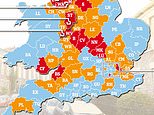Could you pick out the Starbucks barista who served you two weeks ago in a busy crowd at a concert?
If so, you could be one of the 0.1 to one percent of people known as 'super recognizers', whose brains have an amazing ability to remember faces.
For these people, a brief glimpse is enough to identify an incognito celebrity or remember a complete stranger, even years later.
Some can also identify or match faces they have seen once, even if they're flipped upside down, pixelated, or shown at a different angle.
A pandemic-era study even found that super-recognizers could identify a masked person based on their eyes alone.
Though the research is still new, experts suspect that super-recognizers have spikes in brain activity when they recognize a face which tells their brains that this is an important piece of visual information.
Instead of that data being discarded by the brain in favor of something different in the coming days, weeks and months, these people's brains keep holding onto it.
Dr Richard Russell, a professor of psychology at Gettysburg College in Pennsylvania, said in 2021: 'Society operates under the assumption that everybody is about the same at recognizing faces, and that everyone sees the world in the same way. 'That simply is not true.'
If you think you're a super-recognizer, see if you can identify the upside down celebrity photos below.


Dr Russell was part of a team of researchers that coined the term 'super-recognizer' in 2009 with a study of four Americans who claimed to have 'exceptional' recall when it comes to faces.
They were able to identify photos of celebrities from before they were famous and pictures from different angles and with pixilation.
Dr Meike Ramon, an assistant professor at the University of Lausanne in Switzerland, told the Washington Post that super-recognizers have a 'unique ability to derive a three-dimensional representation of a face, even when they see only one 2D image of the person.'
Dr Ramon's research suggests that super-recognizers are also particularly drawn to faces.


In a 2022 study, she and her colleagues found that even when super-recognizers were shown random pictures of everyday life - someone using a computer, for example - they spent the most time looking at faces.
Their eyes were also drawn to faces immediately, regardless of where the face was in the photo.
Dr Ramon said: 'It seems like faces are extremely salient for super-recognizers for reasons that we still don't know.'
She noted that their brains also appear to respond differently to images within a second of seeing them.


A 2024 study conducted by Dr Ramon's lab looked at brain activity of 16 super-recognizers and 17 controls while participants looked at pictures of plants, animals, faces, and other scenes.
In just 65 milliseconds of an image showing up, which is faster than the blink of an eye, their brains immediately responded differently than the control group.
On the other end of the spectrum from super-recognizers are people with prosopagnosia, better known as face blindness.
The two to three in 100 Americans with this condition have trouble recognizing even the most familiar faces, including their own, as well as noticing emotions or a person's age or gender.
Most people acquire face blindness from neurological conditions like dementia, brain tumors, and seizures, as these can cause brain lesions that destroy cells responsible for processing visual information.
However, some people may be born with it due to genetic mutations.


Experts noted that while super-recognizers have exceptional recall, their abilities aren't perfect.
Dr David White, lead investigator at the Face Research Lab at the University of New South Wales in Australia, told the Washington Post that just like typical people, super-recognizers also find it more difficult to distinguish faces of people of different ethnicities than their own.
However, one study by his team showed that when super-recognizers made errors, they maintained higher confidence than other professionals who need to study faces, such as police officers.
If you're trying to improve your facial recall, Dr White's research suggests to focus on features like scars, ears, freckles, and blemishes.
His team also developed an online test to determine if you're a super-recognizer.
It comes after a study earlier this year revealed the terrifying condition known as 'demon face syndrome.'


Known medically as prosopometamorphopsia (PMO), only about 75 cases have ever been documented of the syndrome, in which a person perceives unusual, often grotesque distortions when staring at a human face.
But a rare individual with the condition, a 58-year-old male who reached out to neuropsychologists at Dartmouth, has the unique ability to see faces normally on paper and on screens, despite seeing more eerie 'demon faces' in his real life.
This split allowed him and the researchers to reliably illustrate, for the first time, what faces can look like for a person living with the haunting vision of PMO.


'Most of the articles about PMO have been brief case reports about individual cases,' Dartmouth Professor Brad Duchaine told DailyMail.com, 'written by the neurologists who happened to encounter them in their clinical practice.'
'Our report is especially interesting,' he said, 'because [...] we can be confident that the distortions of his visualizations accurately reflect what he experiences.'
A rare individual with a variation of the 'demon face syndrome' has the unique ability to see faces normally on paper and on screens, despite seeing more eerie 'demon faces' in his real life.
The divide allowed researchers to properly illustrate, for the first time, what faces look like to a person living with the demon-tinted glasses of prosopometamorphopsia (PMO).












